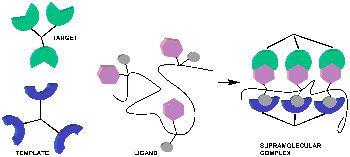Polymer scaffolds hook up toxins to proteins that destroy them
Polymer scaffolds that pin molecules together at multiple binding sites can trap and destroy E. coli toxins by locking them to immune proteins, researchers based in Canada and Japan have found. The polymers, which have only been tested in mice, could be used in a combination therapy to mop up the soluble toxins that E. coli cells release when attacked by antibiotics.
David Bundle at the University of Alberta and colleagues hope their toxin-mopping concept could eventually provide a new class of inhibitors to tackle other diseases, including cholera and cancer.
The bacterium E. coli 0157:H7, known for causing food poisoning, releases a doughnut-shaped Shiga toxin (stx1)made up of five identical segments. Left unchecked, the toxin disrupts protein synthesis in cells, and can cause the kidney failure and anaemia that results in extreme cases of food poisoning. Because such toxins are released by E. coli 0157:H7 cells when they burst, antibiotics aren’t usually given for these infections, says Bundle.
Supramolecular sandwich
Bundle and colleagues designed a new inhibitor - a polyacrylamide scaffold decorated by ligands, dubbed (S)-PolyBAIT - which not only binds the toxin, preventing it entering cells, but also redirects it to the liver for disposal. It does this by sandwiching it together with an immune protein responsible for clearing cellular debris - serum amyloid P (SAP).

’We realised that five binding sites on the SAP molecule were in the same spatial distribution as the five sites on the E. coli toxin. They were in perfect registry,’ says Bundle. (S)-PolyBAIT, with multiple ligand pairs on its chain, helps a tight covalently-bound complex form between SAP and stx1. Without the multiple binding interactions assisted by the polymer backbone, the toxins would not be trapped.
The research builds on earlier attempts to trap the toxins using five-armed molecules called ’Starfish’, which also relied on multiple binding interactions to increase their activity. Bundle says (S)-PolyBAIT’s activity in mice is higher still, due to its increased stability.
Ravi Kane, a molecular engineer at the Rensselaer Polytechnic Institute in New York, says, ’This strategy of using the endogenous [SAP] protein as both a template and an effector is very clever and could be applied to target other toxins and diseases.’
’You could also address this to cholera toxin,’ agrees Bundle. And because clustering of receptors can trigger cell death, he adds, he also hopes that drugs which establish multiple interactions between receptors could target cancer cells. His team are already working on a treatment for myeloma, a cancer which affects immune cells.
Hayley Birch
Enjoy this story? Spread the word using the ’tools’ menu on the left.
References
et alPNASDOI: 10.1073/pnas.0804919105






No comments yet